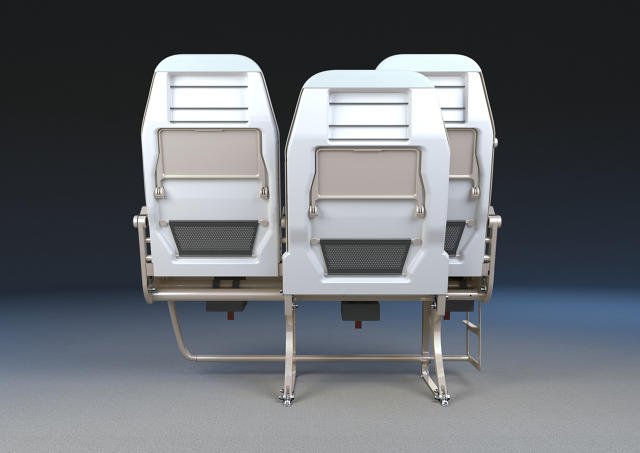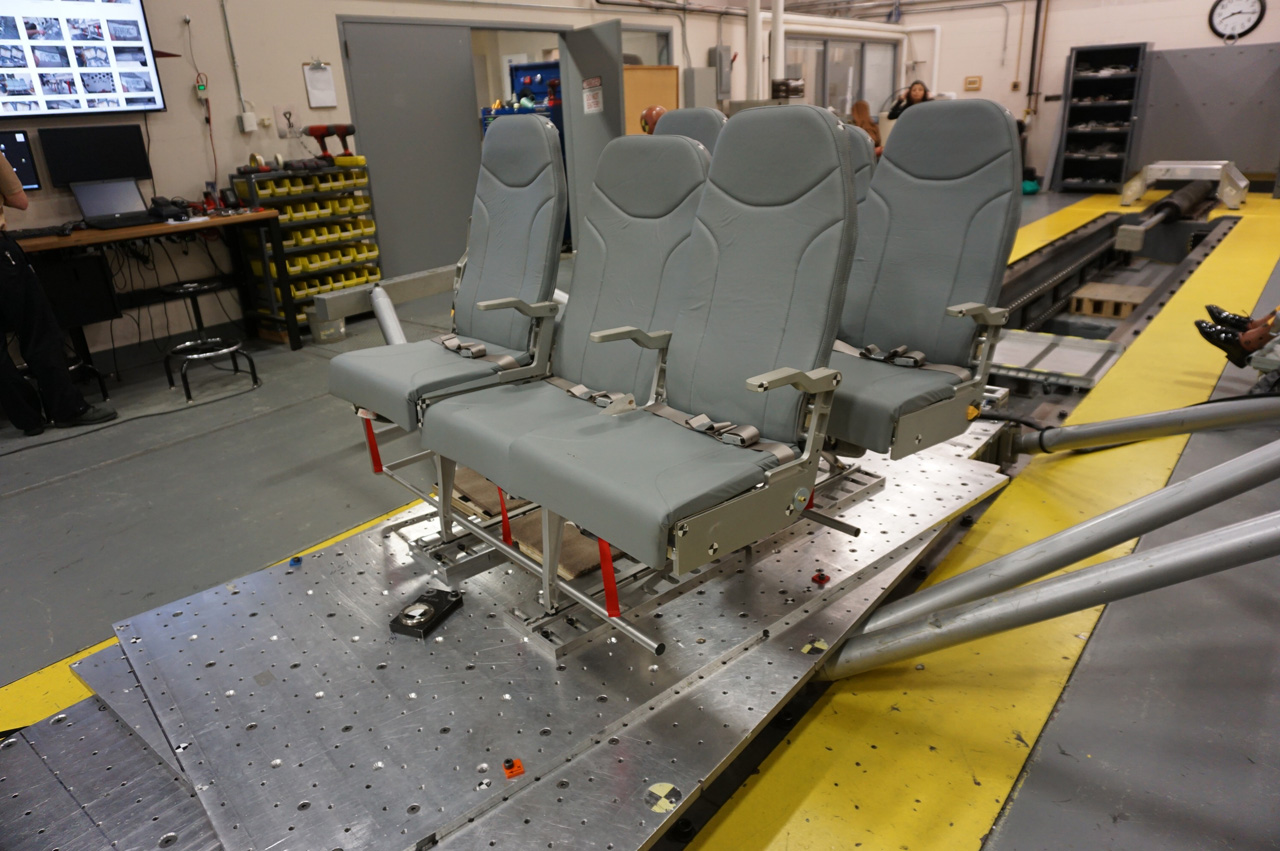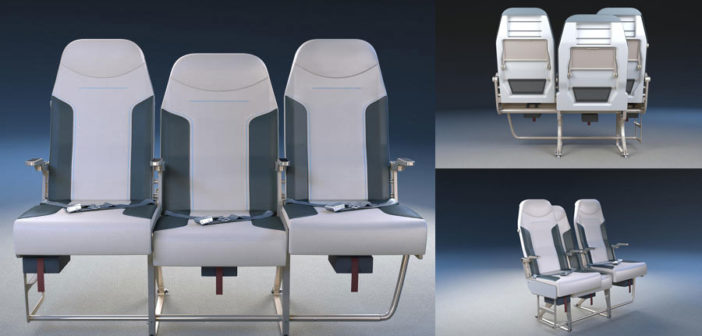The staggered design means more space, and no more fighting over elbow room. But there’s a catch.
No one wants the middle seat on an airplane. But the Colorado-based startup Molon Labe Designs may change your mind with an airline seat row that offers significantly more space for flyers—even those in the middle seat. It’s called the Side-Slip Seat.
Designed for flights three hours and under, each row of seats features a staggered design. The middle seat is set slightly lower and behind the aisle and window seats, a discrepancy that makes the backrest of the middle seat just under three inches wider than the standard 18 inches. This is an easy sell for flyers—even though there’s no extra legroom (that’s controlled by the airline), the middle seat is more spacious, and the staggered design means that there’s no need to fight over elbow room.

Great for flyers, but what about cash-strapped airlines whose business relies on cramming as many people onto a plane as possible? That’s where the second key design comes in. Because the middle seat is offset, the aisle seat can literally slide on top of it to make the aisle wider during boarding, easing the traffic jam that always occurs as people put bags in the overhead compartment and get settled. This means that airplanes could be boarded faster.
“We often joke we’re a stress reduction company. The entire design came out of my stress at flying,” says Molon Labe Designs founder Hank Scott. “But no one is going to buy a seat because it just makes the customers happier. We offer the airlines less fuel and better profits through faster turnarounds.”
Scott, an ex-pilot for the Australian Navy, former test pilot, and an engineering professor at University of Colorado Boulder, first came up with the idea for the Side-Slip Seat because he was frustrated with the amount of time it took to board an airplane. He partnered with another engineering professor from the University of Colorado and began to build prototypes and solicit feedback from the public and the airline industry. Now the seat is in its fifth full iteration and has undergone extensive crash testing: It’s set for crash testing at the FAA in the next two months. That’s the final regulatory barrier between the Side-Slip Seats and the skies, though Scott has to convince the airlines that the design makes business sense. And the Side-Slip Seat doesn’t just rethink airplane seats; it rethinks the entire boarding process.
Picture this: When a standard 747 airplane outfitted with Side-Slip Seats is empty, it’ll appear to only have two seats on each side of the main aisle. The first person boards, finds his middle seat in row 40, and in one motion pulls the aisle seat to its proper position, locking it in place. The second person boards, finds her aisle seat on the other side of row 40, and similarly slides the seat into position and sits down. Now the aisle between row 40 is the standard aisle size of 20 inches, but the aisle on the rest of the aircraft remains double the size. That means there’s enough room for travelers to go around others who are putting their bags in the overhead compartment, or who are blocking traffic as they fish out their laptop. The rows get expanded once a middle-seat passenger or aisle-seat passenger sits down, but there’s no requirement that either of these passengers boards first or last. The wider aisle has the added bonus of being more accessible to wheelchairs for flyers with disabilities. “There is a law of diminishing returns—the aisle gets skinnier and skinnier,” says Scott. “But until the last person loads, we have the widest aisle of any airplane on the planet.”
According to Scott, shaving 10 minutes off boarding time for major airlines would result in hundreds of thousands of dollars in savings—every minute an airplane spends on the ground costs them between $81 and $100. So while each Side-Slip Seat is 5% heavier than the industry standard, Scott claims that the faster loading time means greater savings.

Scott says that the most efficient airlines spend about 30 minutes on the ground between flights to deplane, clean, refuel, and board. While on the ground, an auxiliary propulsion unit powers air conditioning and all the electronics on board, using about 50 gallons of gas per hour. If the seat design can shave off 10 minutes of boarding time, which is the most time-intensive part of the process, that’s saving about 10 gallons of gas. If you’re Southwest Airlines and have 3,500 turnarounds every single day, you could be saving 35,000 gallons of gas and tens of thousands of dollars every day on fuel.
It could also help carriers squeeze in an extra flight, Scott says. If you have seven flights out of one city from 7 a.m. to 10 p.m., spending 10 minutes fewer on the ground between flights means you’ve saved about an hour of time. This could enable a carrier to add another flight to its schedule, meaning you wouldn’t necessarily need as many aircraft in your fleet, a tactic called fleet utilization.
Still, it’s unclear how much extra fuel a 5% weight increase would require, and if that would offset the potential price savings of faster boarding. Also, the Side-Slip Seat doesn’t recline—why it’s designated for shorter flights—which is great news for the tall guy behind you, but might not be as appealing to you. (This week, Molon Labe Designs announced another model suited to longer flights that do recline and include extra padding and an in-flight entertainment system.)

Scott acknowledges that this new way of boarding an aircraft will be downright confusing for some people. “It’s funny to think, our design in different parts of the world will have different levels of success,” he says. “In a disciplined place like Japan it will be incredibly efficient. If you take a bunch of New Yorkers, it may not be as efficient but it certainly will make some of them a lot happier. The culture of the people using the seat and the culture of the airline will dictate how much stress reduction actually occurs.”
Scott says the Side-Slip seat will be flying by the end of 2017, and he’s had conversations with 26 airlines, including big providers like Boeing and Airbus. Molon Labe is currently expanding its facility to produce more of the seats.
This article first appeared in www.fastcodesign.com
Seeking to build and grow your brand using the force of consumer insight, strategic foresight, creative disruption and technology prowess? Talk to us at +9714 3867728 or mail: info@groupisd.com or visit www.groupisd.com

